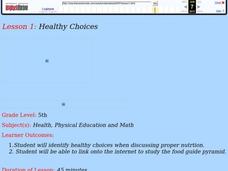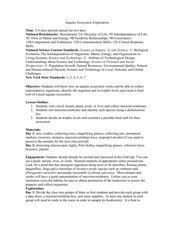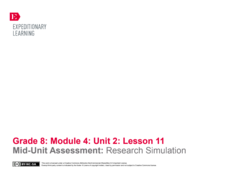Curated OER
Week 8 - Sea Life
Using a magnifier, mini marine biologists examine the barbules of a bird feather. They swirl the it into a mixture of oil and water and then re-examine the feather. After the activity, discuss how the oily feathers pose a problem to...
Curated OER
Healthy Choices
Fifth graders discover how to make healthy choices in nutrition. In this nutrition lesson, 5th graders research the daily nutrition requirements recommended by the U.S. Department of Agriculture. Students keep a food diary for three days...
Alabama Learning Exchange
Nature's Life Cycle
Become a member of the Pollution Patrol and stand up to litter! After discussing the life cycle of seeds and discussing how plants figure into the food chain, young conservationists engage in several activities involving podcasts,...
Curated OER
Mouse Roulette
Young scholars explore the food chain. To gain an understanding about the food web, students participate in a simulation where owlets are being fed by adult owls. Afterward, young scholars examine the results of the role play to...
Curated OER
Salads
Use a PowerPoint presentation to introduce the classifications for salads in our culture. Viewers take notes and then work through the ratio of ingredients in a vinaigrette salad dressing. Finally, they mix up the vinaigrette. This...
Curated OER
Marine Ecosystems
Students identify producers and consumers and construct a food chain from four marine ecosystems. They describe the delicate balance among organisms in each environment. In groups, students discuss the human activities that upset the...
Curated OER
Snack Attack - Food Packaging
Class members examine a variety of snack foods, noting the packaging that they come in. They work in groups to design a heat-proof and waterproof package that will safely transport a s'more snack. They test to see if it prevents the...
Curated OER
Aquatic Ecosystem Exploration
Learners visit a local stream, pond, creek, or river and collect macroinvertebrates. They sort macroinvertebrates and identify each species using a dichotomous key. Students decide on trophic levels and construct a possible food web for...
Curated OER
Links in the Chain of Life
Using the prairie dog community as an example, middle school ecologists examine the food web. Pairs of learners take one species in the community and research its role in the ecosystem. They share their findings with the rest of the...
Curated OER
Harvest Food Garland
Students explore the celebration and traditions of various harvest celebrations such as Thanksgiving, Sukkot, and Kwanzaa. They design paper harvest decorations such as fruits, vegetables and wildflowers. Using these drawings, students...
Curated OER
Looks Good Enough to Eat
Students examine food photography and the different techniques used by food stylists to make foods look appealing in advertisements. After learning some of the tricks of the trade, students plan and shoot their own food advertisements.
Curated OER
Globalization Comes to the Table
Learners, in groups, research the issues surrounding one of several controversies involving food and globalization. Then they debate their position and show a PowerPoint presentation at a mock summit meeting.
Curated OER
Sustainable Livestock
Young scholars investigate healthy eating habits by researching livestock. In this food sustainability lesson, students research the negative impact factory farming has on our environment due to pollution. Young scholars define...
Curated OER
Fortified Breakfast
Students reverse engineer a cereal. In this dietary lesson students identify the minerals that the human body needs to function. Students examine how foods are fortified by food engineers. Students find the amount of iron in a cereal by...
Curated OER
What's on My Plate?
Kids work together in groups to discuss and understand the differences between a typical diet and a healthy one. They use the My Plate recommendations to compare what they eat with what they should be eating according to the MyPlate...
Curated OER
Traveling Through the Digestive System
Second graders learn about how the food is broken down in our bodies and the job of each body part involved in our digestive system. The utilize the CD ROM game, "Body Works." This wonderful game takes pupils through the human body's...
Texas Heart Institute
Nutrition: How Do I Choose the Right Foods?
Young learners discuss how to practice healthy eating habits and the body's need for energy through discussion and exploration of the MyPlate system.
Nemours KidsHealth
School Lunch: Grades K-2
Two lessons encourage scholars to make smart eating choices. The first lesson sorts food items into the MyPlate's food groups. Learners scour magazines to cut and paste examples onto a paper plate that showcases each group. Then, draw...
Consortium for Ocean Science Exploration and Engagement (COSEE)
Understanding the Food Web
Building on prior knowledge of the pervious instructional activity in the series, pupils explain the previous instructional activity to each other. Then they write a simple guide for a young child to read on the same topic.
Nemours KidsHealth
Breakfast: Grades 3-5
Two lessons promote starting the day with a balanced breakfast. Lesson one challenges scholars to create their own cereal after examining their current favorite cereal, including its nutrition facts. In lesson two, learners set their...
Virginia Department of Education
Macromolecules
Finally, a chance for the class to play with their food! Allow pupils to simulate stomach acid with common foods, and introduce specific macromolecules into the mixture to explore characteristics of carbohydrates, lipids,...
BioEd Online
Serving Sizes
When it comes to eating a balanced diet, portion control is paramount, but what is the difference between the serving size on the nutrition facts label and a portion as determined by the USDA? In a comprehensive look at portion control,...
Nemours KidsHealth
Healthy Snacking: Grades 6-8
Two activities focus on healthy snacking. In the first activity, scholars create a poster displaying two messages—pack a healthy snack and make good food choices. The second activity challenges pupils to draft a snack list and tag along...
EngageNY
Mid-Unit Assessment: Research Simulation
As part of a mid-unit assessment, scholars complete a research simulation about food deserts to mimic the research process. Afterward, they engage in a think-pair-share to discuss what they've learned throughout the unit.
Other popular searches
- Food Pyramid
- Food Chains
- Food Groups
- Food Webs
- Food Labels
- Food Safety
- Desert Food Chain
- Esl Lessons Food
- Animal Food Chain
- Deciduous Forest Food Chains
- Nutrition Labels
- Healthy Foods























